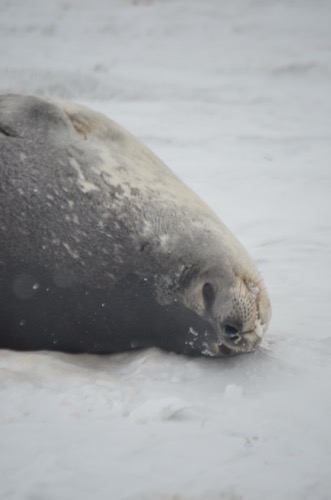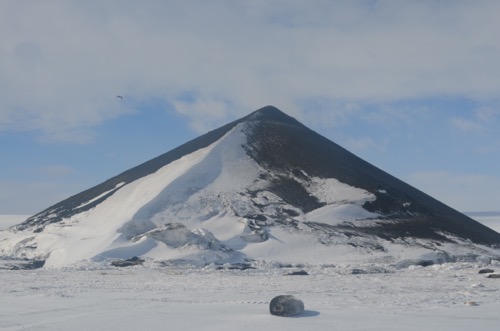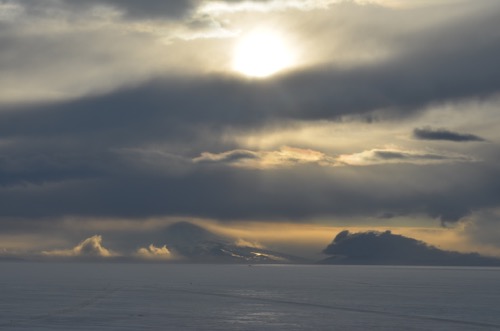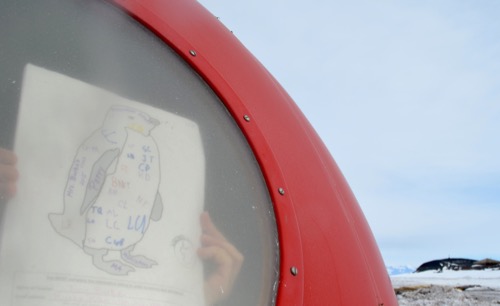Research Update
Today our team went to Turtle Rock to collect our last sediment samples from the seafloor. Turtle Rock is about 8 miles from McMurdo Station and is less affected by humans than our seafloor samples at the Station. Divers, including team member Terry Palmer, collected sediment samples and sealife from 40, 80 and 120 feet depths.
 Michelle Brown holds a large sea star collected from the dive site at Turtle Rock.
Michelle Brown holds a large sea star collected from the dive site at Turtle Rock.
Although it snowed in the morning, the afternoon was beautiful. It was so much fun to leave McMurdo Station and sample sediments at Turtle Rock!
 Team B518 jumps for joy after a lovely day at Turtle Rock.
Team B518 jumps for joy after a lovely day at Turtle Rock.
Seals on the Ice
Turtle Rock is a special place, especially around this time of year. At the end of October, Weddell seals give birth to their pups. Many of the mothers nurse their young around Turtle Rock. The mothers and seal pups were still there when we visited today. Weddell seals are safe from killer whales at Turtle Rock. The Weddell Seals can hold their breath for up to 45 minutes, which is longer than the killer whales. Therefore, the seals can reach Turtle Rock, swimming beneath the sea ice, while the killer whales cannot. In fact, no other mammal can survive where the seals can. They keep the holes near Turtle Rock and other locations open by scratching them with their teeth. Although the holes are often only large enough for their noses, it allows them to breath and stay alive! At Turtle Rock there are also cracks in the ice that let them get up to the surface.
 A mother and baby Weddell Seal lie on the sea ice at Turtle Rock.
A mother and baby Weddell Seal lie on the sea ice at Turtle Rock.
While our dive team collected organisms and sediment samples, I took a moment to watch the seals surrounding our dive hut.
 A Weddell Seal looks over at the camera after snoozing on the ice.
A Weddell Seal looks over at the camera after snoozing on the ice.
 A Weddell seal lies in front of Turtle Rock--an outcrop off the coast of Ross Island.
A Weddell seal lies in front of Turtle Rock--an outcrop off the coast of Ross Island.
All About Seals
Weddell Seal pups are already born by early November. After 2 - 3 weeks, the mother begins to leave the pup alone for short periods of time. By 7 weeks, the pups are weaned and weigh 220 pounds or more. Mothers and pups use smell to identify each other. It is common to see mother and baby pups sniffing each other! However, the mother may reject the pup if it has an unfamiliar scent.
 A newborn pup sleeps near a mother Weddell Seal.
A newborn pup sleeps near a mother Weddell Seal.
Studying Seals
During our visit to Turtle Rock, three people arrived on snowmobiles to collect census data on the seals. They are part of a research team, operating since 1968, that has come to track the breeding populations of Weddell Seals since 1968. You can learn more about their work at: www.weddellsealscience.com
 A research team studying Weddell Seal populations stops by Turtle Rock to collect some data.
A research team studying Weddell Seal populations stops by Turtle Rock to collect some data.
Life in Antarctica
Although there are lots of places at McMurdo Station that make me feel like I'm back at home, there are also moments that remind me that I am in Antarctica. I took in the beauty of the view South on my walk back to my dorm yesterday at 11 p.m.
 A beautiful view of islands and the continent at 11 p.m. at McMurdo Station.
A beautiful view of islands and the continent at 11 p.m. at McMurdo Station.
Critical Thinking
Why was the sun up at 11 p.m.? In fact, the sun is up 24 hours a day. How does this work?
Brought to you by...
Today's journal was brought to you by Ms. Burke's class from the Placentino School in my home town of Holliston, Massachusetts!
 Today's journal was brought to you by Ms. Burke's class at the Placentino School in Holliston, Massachusetts.
Today's journal was brought to you by Ms. Burke's class at the Placentino School in Holliston, Massachusetts.
Comments
Pagination